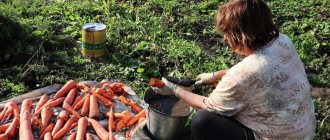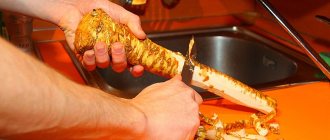How to properly store carrots: 8 ways
Of all the root crops grown by gardeners in their summer cottages, carrots are the most difficult to preserve during the winter.
The inquisitive minds of gardeners have come up with many ways to store carrots: in cellars, on balconies, in apartments and even directly in beds. How to properly store carrots? Based on the existing conditions, the complexity of the process and the availability of materials, choose the most suitable storage option for you from the storage options offered below.
Preparing carrots for long-term storage
The first rule for good preservation of the carrot harvest is proper and timely harvesting.
The ripening time for carrots depends on the variety and is usually indicated on the packet of seeds. It is better not to throw away the bag or to calculate the expected harvest day in advance, in the spring. Why? Carrots pulled out ahead of time do not ripen and do not have time to accumulate a sufficient amount of sugars, which negatively affects its taste. Carrots that are over-exposed in the garden, on the contrary, have an excess of sugars and amino acids, and this, in turn, makes them a tasty morsel for pests - carrot fly larvae, mice and rats.
If you still don’t know exactly when to harvest carrots, focus on the color of the tops. As soon as the lower leaves begin to turn yellow, the carrots are ready for harvesting. To ensure that root crops remain juicy for a long time, they should not be watered the day before digging.
Immediately after harvesting, the tops of the carrots are cut off. Otherwise, it will draw some of the moisture from the root crops during drying. It is best to trim carrot tops in two stages: - first, the leaves are cut off just above the head of the root crop, - then the “head” is cut off completely (0.5-1 cm thick) together at the growth point, and the cut should be even and smooth. Such drastic pruning prevents carrots from germinating in winter, wasting precious nutrients, prevents fruits from withering, and ensures their best storage.
After cutting the tops, the carrots are ventilated under a canopy or dried in the sun for 2-3 hours. It is recommended to keep carrot roots at a temperature of 10-14 °C for 7-10 days. During this time, just like potatoes put into storage, they undergo a kind of “quarantine”: cut points and minor mechanical damage heal, sick and spoiled root crops make themselves known.
Before harvesting carrots into storage, they are inspected and sorted again, removing all unsuitable root crops.
Method No. 1. How to store carrots in sand
You will need: sand (preferably loamy, not river sand), water and boxes. Storing carrots in sand is very popular among summer residents who have cool cellars, crawl spaces, and garage pits. And it is not surprising, because sand reduces the evaporation of moisture from carrots, prevents the development of putrefactive diseases, and ensures a constant temperature - all this contributes to the excellent shelf life of root crops.
The sand must be wet; one liter of water is used for moistening each bucket of sand. Then the prepared sand is poured onto the bottom of the box in a layer of 3-5 cm, after which the carrots are laid so that the root vegetables do not come into contact with each other. The carrots are covered with a layer of sand, and then the next layer is laid out, etc. Some gardeners prefer to use dry sand instead of wet sand and buckets instead of boxes.
Method No. 2. Storing carrots in sawdust
You will need: pine sawdust and boxes. Sawdust from coniferous trees is another excellent filler for boxes of carrots intended for long-term storage. The phytoncides contained in the needles prevent the germination of root crops and prevent the penetration of pathogenic fungi and bacteria. In the same way as when sanding, carrots need to be placed in boxes in layers, sprinkling each layer with sawdust.
Method number 3. How to store carrots in plastic bags
You will need: film bags with a capacity of 5 to 30 kg. Plastic bags with carrots are kept open in cool rooms. The air humidity in such bags naturally remains at the optimal level of 96-98%, and therefore the carrots do not wither. In addition, carrot roots emit carbon dioxide during storage. In open bags, a small amount accumulates, just enough to prevent disease. If the bags are tied, the carbon dioxide content will be several times higher than the oxygen concentration and the carrots will spoil.
If you still want to store root vegetables in closed bags, be sure to make holes for ventilation. During storage, condensation may form on the inner surface of the bags - this indicates increased humidity in the storage. Then fluff lime is scattered next to the bags of carrots, which absorbs excess moisture.
Method number 4. Storing carrots in clay
You will need: clay, water, boxes or cardboard boxes, plastic film, garlic (optional). Clay forms a thin protective layer on the surface of the root crop, which protects it from withering during the winter. There are two options for treating carrots with clay before storing them.
Option 1.
Filling with clay Take half a bucket of clay and fill it with water. A day later, the clay, swollen with water, is thoroughly mixed and filled with water again. For 3-4 days, the clay is in this state, under a layer of water of 2-3 cm. Before use, the clay must acquire the consistency of sour cream. Then the bottom of the boxes is lined with film, a layer of carrots is placed (so that the fruits do not touch each other) and filled with liquid clay. When the layer of clay dries, the carrots are laid out again and also filled with clay, and then dried again. And so on until the very top of the box.
Option 2.
Dipping in clay With this method, unwashed carrots are dipped first in garlic and then in a clay mash and laid out to dry in a well-ventilated area (on the veranda, in the attic, under a canopy). Then the dried carrots in the “clay shell” are placed in wooden boxes or cardboard boxes. Garlic mash is prepared as follows: grind 1 glass of garlic through a meat grinder, then dilute the “minced meat” in 2 liters of water.
To get a clay “mash,” you need to dilute the clay with water to the consistency of thick sour cream, so that it cannot then drain from the root vegetables.
Method No. 5 Storing carrots in moss
You will need: wooden or plastic boxes, sphagnum moss. Unwashed and sun-dried carrots are first kept in a cool room for 24 hours, and then placed in boxes, alternating layers of carrots with layers of sphagnum moss. Moss has unique preservative properties and retains the required amount of carbon dioxide inside. In addition, unlike sand and clay, moss is a lightweight material that does not add additional heaviness to boxes of carrots.
Method number 6. Storing carrots in pans
You will need: large enamel pans. After harvesting, carrots must be washed well, the tops and tails must be trimmed, and the roots must be dried in the sun. Then the root vegetables are placed tightly vertically in the pan, a napkin is placed on top of them and the pan is covered with a lid. It is recommended to keep all pots with carrots in a cool cellar - then the carrots will last well until the new harvest.
Method No. 7. How to store carrots in onion skins
You will need: boxes, onion and garlic peels. This method of storing carrots is based on the same principle as storing them in pine sawdust - essential oils from onion and garlic scales also prevent rotting of root vegetables. Therefore, carrots do not spoil for a long time if they are laid in layers, having previously been sprinkled with dry peels of onions and garlic, remaining after harvesting these crops and accumulated over the winter.
Method No. 8. Storing carrots in the garden
Some gardeners leave part of the carrot harvest to overwinter directly in the garden bed, then dig it up in the spring and eat it all summer until the new harvest. The tops of carrots left for storage in the garden bed are completely cut off. Then the bed is covered with damp coarse sand and covered with film. Sawdust, fallen leaves, peat or humus are poured on top of the film, and then the bed is covered with roofing felt or another layer of film.
Vermiculite
Vermiculite is a special natural mineral that has proven itself to be used in summer cottages. This includes drainage, mulch, and even a substrate for seed germination. And in addition to everything, it can also be used for storing vegetables, of course, provided that you can provide yourself with a sufficient amount of this material.
Now that you know all the pros and cons of substrates that are used to store various substances, you can choose the one that is most justified for you.
The best ways to store carrots for the winter
As you know, root vegetables are not difficult to store; almost all of them do not require special conditions, but carrots are an exception. Every gardener and gardener should know how to properly store carrots for the winter, otherwise he risks losing his harvest, and the work he did in the summer and spring will go down the drain. Therefore, today we invite you to familiarize yourself with the best ways to store carrots, choose yours, and enjoy a large harvest that will provide you with this root vegetable for the whole winter.
Onion peel
Onion skins are not the most obvious member of our list. Perhaps because collecting enough of this substrate to store the entire crop is a rather difficult task. However, this method can also be taken into account as a backup option if you need to preserve a small harvest.
The most common practice in our region is adding onion skins to bags or boxes of pears.
- Whoever undresses it receives benefits - 7 ways to use onion peels in the country
Onion skins are a superhero ingredient. There is no pest that could escape from an onion-based drug alive.
Preparing carrots for winter storage
To prevent the root crop from being negatively influenced by the external environment, we need to take care of this in advance. The first thing you need to think about is, of course, preparing the vegetable for this.
When to remove carrots from the garden for storage
- The first thing to do is to harvest the crop on time; often there are deadlines on the package of seeds that determine the time of planting and harvesting; you need to adhere to them. If you threw away the bag and don’t know when to remove the carrots, you can use the color of the tops as a guide; the yellow lower leaves are a signal to harvest.
- After you have removed it, immediately trim the tops; they draw out the moisture of the carrot while drying. Proper trimming of the tops will ensure that the root crop does not germinate in the winter season. They cut it in two stages, first we cut the leaves, taking them a little higher than the root crop, then we cut off the head, and with it the growing point, cut evenly and smoothly.
- Next, the carrots arrange a kind of quarantine, they are stored for two weeks at a temperature of about +14C, after this period, they look through all the vegetables again, cut off the blackening, and weed out the spoiled carrots.
Storing carrots in sand.
We need to prepare: Sand (it’s better not to take river sand), some water, and wooden boxes.
This storage method is often used by summer residents and gardeners who have large cellars or, for example, a garage with a pit.
The sand needs to be moistened; for one bucket of sand, use a liter of water to moisten it. We lay sand on the bottom, in a small layer, about 4 centimeters, after which we lay out the carrots, make sure that the root vegetables do not touch each other, after which we cover them again with a layer of sand, put the carrots on it again, it turns out like a layer cake, continue making layers to the top of the box.
How to store carrots in sawdust.
Required materials: box and sawdust from coniferous trees.
The method of laying carrots in sawdust is the same as when storing them in sand, just lay sawdust instead of sand, in the same layers.
Storing carrots in plastic bags.
Required materials: plastic bags with a capacity of up to 30 kilograms, at least five.
The advantage of this method is that in bags, air humidity always reaches values above 90%, which is excellent for such root vegetables. Store bags in cool and dry places. The bags are not closed, or they have a lot of holes for ventilation, otherwise carbon dioxide will ruin your entire harvest.
When you notice that condensation has appeared on the bags, this means that the humidity in the room is higher than normal, and you should scatter the well-known millet near the bags.
Storing carrots in moss for the winter.
Required materials: wooden or plastic boxes, moss.
There is no need to wash the carrots, but be sure to dry them in the sun and then leave them in a cool and dry place for a day. Next, we take a box, and lay sphagnum moss on its bottom, and alternate layers of moss and carrots, as we did with sawdust and sand.
How to store carrots and beets video tips:
As you can see, there are plenty of ways to properly store carrots for the winter, and they are different, you can choose the one that suits you best, the main thing is not to forget to remove the carrots from the beds in time, this is 50% of successful storage of root vegetables, with the rest you should not have any problems no problem. We wish you good luck and excellent harvests, see you again on our website. All the best!
Source: svoe-hozyaistvo.ru
Sawdust
The use of sawdust is another fairly common technology for storing vegetables. It is not much different from the “sand” method, except that the “preservative substrate” must be extremely dry. The basic principle is still the same: alternating layers of sawdust and fruit.
Sawdust differs favorably from sand in that it is much lighter, i.e. For storage you can use not only wooden boxes, but also cardboard boxes. In addition, vegetables preserved in this way are easier to remove from the container and wash.
- 16 original ways to use sawdust and shavings in the country
We'll tell you what you can do with sawdust on a country plot.
How to properly store carrots for the winter - only working methods
Among the root crops grown on dacha acres, winter storage of carrots is the most difficult for gardeners. What ways have inventive people's minds come up with so that the harvest does not suffer, but is used profitably! They have learned many ways to prolong the shelf life of colorful root crops on balconies, underground, in apartments, and even in the ground in garden beds. Which of these methods is the best? The choice will depend on existing conditions.
Photo: https://i.ytimg.com/vi/mlsriXt2clA/maxresdefault.jpg
Preparation: what do you need to have and what material to choose?
To create optimal conditions for long-term aging of root crops, sawdust, durable boxes and a cool place for storing containers will be useful. The amount of sawdust depends on the volume of the harvest. It is better to put vegetables in wooden containers that hold no more than 18 kg. The boxes should be lowered into moderately cold places - a basement or garage pit .
To store the crop, it is recommended to take sawdust only from coniferous trees. It is this material that contains phytoncides to protect the vegetable from bacteria and fungi. The humidity of sawdust should fluctuate between 10-13%. When laying, it is important that the material completely envelops each fruit.
Basic rules for preparing carrots for winter storage
Carotene root vegetables are best preserved in time and properly harvested. The ripening time must be calculated depending on the specific variety. They are indicated on the seed packages, but you can estimate the expected date even when sowing. It's clear why this is so important.
Carrots removed from the soil ahead of time will be immature and will not have time to gain enough sweetness and show their true taste. Carrot flies and rodents begin to attack root crops that have been left in the ground for too long. If you haven’t decided on the harvesting date in advance, you can focus on the condition of the tops. Yellowing of the lower leaves is a sign of readiness for digging.
Trimming and ventilation
To preserve the juiciness of the crop for a long time, do not water the carrots before digging. After being removed from the ground, the leaves are cut off immediately, since they will draw some of the juices from the fruit when drying. Proper pruning involves two stages. First, the leaves are removed just above the head, then the head itself is cut off by 0.5-1 cm.
The growing point is completely removed so that during storage precious sugars and vitamins are not wasted on the appearance of sprouts. Otherwise, it will wilt and wrinkle in advance. The cut must be even and perfectly smooth. After pruning, the root crops are scattered under a canopy, where they are kept for up to 10 days.
This is a necessary measure, the same as with potatoes. This is how the crop undergoes quarantine, minor damage is delayed and air-dried, and root crops are revealed to be spoiled and would obviously not withstand storage. Before putting it into storage, the crop is sorted again, rejecting carrots with traces of rot.
Preparation
Timely harvesting plays an important role for successful long-term storage of vegetables. It is necessary to dig it up without delaying until frost, because already at -3 degrees Celsius gray rot may appear on the root crops and the storage of such carrots will not be long.
The growth of the crop stops already at +4 degrees Celsius, so it is not advisable to keep it in the ground any longer. However, it is also not worth harvesting too early, because transferring root crops from warm soil to cold cellar conditions can also cause significant losses due to rotting.
It is also worth considering the variety of carrots, because the harvest time for early-ripening and late-ripening varieties will differ. Experienced gardeners consider the yellowing of the lower leaves of carrots to be a signal for harvesting. It is best to dig up the crop with a shovel, carefully removing it from the soil, holding it by the tops and shaking off the remaining soil. After the remaining soil on the carrots has dried, you should immediately cut off the tops so that the nutrients do not leave the vegetable and go into the tops.
It is also recommended to dig up this vegetable in good weather. Before storing it, it should be dried for 10-14 days; only dry, clean, undamaged specimens are selected for storage.
For this storage method, it is necessary to have a cellar in which constant temperature and humidity are maintained, and plastic bags of any size. If the harvest is very large, bags that hold 20 kg of vegetables are also suitable.
Original ways to store carrots
Spraying with infusion of onion peels or infusion of pine needles prolongs the preservation. Some original gardeners immerse carrots for 10 minutes in this disinfecting, cold-prepared infusion: 100 g of husk is infused in a liter of water for 5 days. Then it is dried and stored.
Photo: https://1gryadka.ru/wp-content/uploads/2019/09/07-e1567750409847.jpg
If there is a sufficient supply of food stretch film, each carrot is individually wrapped completely, thus preventing it from coming into contact with other carrots. Of course, this method is not for the lazy. And due to the large investment of time, it is not suitable for a generous harvest.
Carrots in paraffin
Also quite unusual, but providing excellent preservation. A small part of beeswax is added to the melted hot paraffin for better elasticity of the coating. Clean, dried root vegetables are quickly immersed and removed. The airtight paraffin film provides 5 months of trouble-free storage at a temperature not exceeding 2 degrees.
Chalk, old newspapers and herbs
Chalk dusting creates a slightly alkaline environment that prevents the development of rot and bacteria during storage. The consumption of powdered chalk in this case is approximately 200 g per 10 kg of root vegetables. The same effect is achieved by dipping carrots in a 30% chalk suspension and then drying them.
Old newspapers or any paper can also be used to wrap each root vegetable to extend its shelf life. If there are rodents in the cellar, they will be repelled by arranging carrots with aromatic herbs, which also have excellent bactericidal properties. For example, Saracen mint, the famous kanufer, has a scent that repels rats and mice. It is enough to lay dry stems on the floor around the boxes to prevent rodents from getting inside.
How to store carrots in the freezer for the winter
If the harvest is small, the available freezer is suitable for storing it. The carrots undergo the same preparation as before cooking, are chopped in a food processor and distributed in individual portions into bags. Then it goes into freezing.
Photo: https://img-global.cpcdn.com/023_recipes/770a87b9333fe6a4/1200x630cq70/photo.jpg
When storing in basements, it is worth considering that optimal conditions there include air humidity at 90-95%. and temperatures close to zero. For carrots, these are ideal preservation conditions until the next harvest.
Source: domstrousam.ru
How to store carrots correctly: 8+ ways
The article provides useful information on how to store carrots correctly: 8+ effective storage methods.
Carrots are one of the many vegetable crops grown by our gardeners that are difficult to store in winter. What methods and places have our enterprising fellow countrymen tried, straining their inquisitive minds: a cellar, a balcony, an apartment and even a garden bed!
How to properly store carrots? Based on the existing conditions, the complexity of the process and the availability of materials, choose the most suitable storage option for you from the storage options offered below.
How to store carrots: proper preparation for winter storage
How to store carrots: proper preparation for winter storage
It is worth emphasizing right away what primarily affects the safety of the carrot harvest. This is the timeliness and correctness of its cleaning! The package with seeds, or more precisely, the information indicated there, will definitely guide you in terms of the ripening time of the root crop. Do not rush to throw away the bag, or mark in a notebook the approximate harvest day calculated on the day of planting. Why is this so important? Because carrots pulled out of the ground early - in addition to the fact that they are not ripe, they do not have enough sugars, and therefore are not tasty.
Can it be stored together?
Orange and burgundy root crops have similar requirements for winter storage. They have the same required level of temperature and humidity. Harvesting of these crops also occurs at the same time.
Both varieties of vegetables winter well in:- sand,
- sawdust,
- clay,
- onion peel,
- peat
This allows you to leave carrots and beets in the same cellar until spring, even in the same container.
Despite such similar characteristics, root vegetables have some differences. Beets are considered a more shelf-stable crop, carrots – more capricious.
That is why ideally these vegetables are kept separately. If this is not possible, then placing them in one box, it is necessary to separate the cultures with a layer of filler.
It is not recommended to place carrots and beets close to each other. At the same time, being together in the same cellar does not affect the quality of both vegetables.
How to store carrots in sand
How to store carrots in sand
This method is quite popular among our gardeners. Especially if there is a cellar, underground or place in the garage. Why sand? - you ask. Sand absorbs moisture released from the fruit, protects against the formation of rot, and with its help maintains a constant temperature. This means that it works for excellent keeping quality of carrots.
So, take a loamy sandy substance. There are gardeners who use moistened sand and even add moisture themselves. The moistened sand is placed on the bottom of the container in a layer of 50 mm, then the carrots are placed (the fruits should lie freely and separately from one another. Lay it out like this: a layer of sand - a layer of carrots...
There are gardeners who do not like wet but dry sand, and use buckets instead of boxes.
Advantages and disadvantages of the method
Storing carrots in sawdust has been a long-practiced method that ensures long-term storage of the vegetable.
Advantages of this method:
- long-term storage;
- reliable protection of root crops from diseases and infections;
- easy cleaning of carrots from sawdust after storage;
- simplicity of organization.
In addition to the undeniable advantages, the technique also has disadvantages:
- the need to have a lot of sawdust;
- each layer needs to be poured, which can be labor-intensive for large volumes of workpieces;
- sawdust tends to generate dust;
- sawdust can provoke allergies.
If the disadvantages of storing carrots in sawdust do not frighten you, then this method can be regarded as one of the best. In addition, even if there is no ready-made sawdust, you can make it yourself.
How to store carrots in polyethylene in winter
Take a bag with a volume of 5-30 kg and put carrots. Store without tying the bag. In a cool room, the humidity inside the bag is quite sufficient for the root vegetables to remain strong and juicy. Carbon dioxide is formed there, and if the bag is closed, there will be too much of it and the root vegetables will spoil. When open, carbon dioxide will be in the required quantity and will serve as a preventive measure against various diseases.
There is another compromise method, when the carrots are placed in closed polyethylene, but with holes for air. If condensation drops form inside the bag, then the humidity is higher than normal. And lime is placed not far from the bag. It will take on excess moisture.
Possible problems and solutions
During storage, problems may arise that affect the quality and shelf life of products. The most important ones are related to changes in temperature, humidity, and the appearance of fungus.
Every problem has its own solutions.
- Change in temperature.
If the cellar is poorly insulated during the winter months, the temperature may drop or rise. If the thermometer shows a critical level below zero degrees, a bucket of smoldering coals can help out. When the temperature rises, the cellar should be ventilated. - Change in humidity. This indicator can be adjusted using salt and charcoal. Moisture-absorbing filler is poured into boxes and placed in the corners of the room.
- The appearance of mold. Lime is used to disinfect the cellar. It kills pathogenic fungi and dries the air at the same time.
To reduce fungal infection of root crops, it is useful to use plants that secrete phytoncides. To do this, carrots and beets are arranged with sprigs of fern, rowan, and tansy.
Buried in clay substance
For this method you will need clay, water, a box (or cardboard box), plastic wrap and garlic. The main element here is clay, which forms a protective film on the surface of root vegetables. Let's imagine 2 options for placing root crops in a protective clay film.
- Pour water into the clay (half a bucket), leave for 24 hours, mix and add water. After 3-4 days, the clay located under a layer of water acquires a creamy state. Then the boxes are prepared: they line the bottom with film, put carrots (the root vegetables should not touch each other) and fill them with liquid clay. Wait for the clay to dry. Then the root vegetables are laid out again and filled with clay again and dried. The steps are repeated until the box is completely filled.
— Prepare 2 mixtures: clay and garlic. The clay is diluted with water to a creamy consistency. Garlic cloves the size of a glass are rolled through a meat grinder and diluted in two liters of water.
The carrots are not washed, but dipped first in the garlic mixture and then in the clay mixture. Carefully lay out the carrots in the open air under a canopy and dry them. Next, the root crops are placed in boxes or boxes.
You can store carrots directly in the garden
Some vegetable growers use a very interesting method of storing carrots. They do not dig it up, but cut off the tops and leave them in the ground until spring.
Of course, the place with root crops is carefully prepared for the winter cold. First, the beds are sprinkled with coarse sand, polyethylene is placed on the sand, and sawdust is poured onto it (fallen leaves or peat are also suitable). And finally they put roofing felt and another layer of polyethylene. Such shelter will help carrots survive the winter and remain juicy and tasty.











